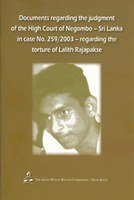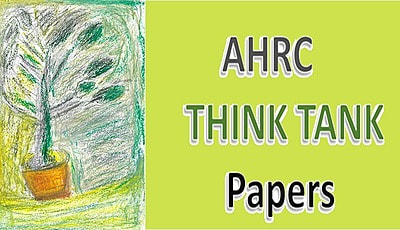Documents regarding the judgement of the High Court of Negombo – Sri Lanka in case No. 259/2003 – regarding the torture of Lalith Rajapakse
VIEW ALL BOOKS This book provides documents relating to the judgement in this case. A brief critique of the judgement is given below.
This book provides documents relating to the judgement in this case. A brief critique of the judgement is given below.
The Negombo High Court of Sri Lanka last week acquitted a sub-inspector of police accused of torturing a prisoner, a crime punishable by seven years’ imprisonment. The High Court judge who tried this case blatantly ignored the evidence and misconstrued the facts of the case.
As the basis of acquittal the court stated in its written judgment: “If the suspect was assaulted on the soles of his feet, particularly if he was assaulted for about thirty minutes, there should be severe injuries on the soles of the feet. But according to the medical report there is no mention of any injuries to the soles of the feet. For the suspect to have been struck on the soles of the feet for thirty minutes without any signs of injury is truly wondrous.”
In contrast to this finding by the judge, the medical report of the assistant judicial medical officer, Dr. Kumudu Kumari Jusa, stated precisely that the prisoner had, in fact, sustained injuries to his feet which the doctor concluded were due to assault.
Therefore the wonder is not as to how there could be no injuries on the feet despite the claim of assault, but how the High Court judge failed to read the medical report and the doctor’s evidence concerning this injury.
This conclusion of the High Court judge is even more shocking because in the later part of her judgment she quotes from the medical report all 10 of the injuries recorded by the medical officer. Thus the finding of the High Court judge about injuries contradicts the facts recorded in the same judgment.
The state counsel in this case was attorney Anupama De Silva. In a lengthy submission she emphasized in great detail the content of the medical report and the evidence of the assistant judicial medical officer, as well as two other doctors. There is no way for the High Court judge not to be aware of these injuries and the evidence of the doctors, since these submissions were made orally in her presence.
She had the written record of the case including the medical report, the doctor’s evidence and the oral submission of the State Counsel. How did she then miss this evidence which is vital to the offense of torture, the crime being prosecuted before this judge?
The defense counsel, who requested several postponements of his oral submission over a period of three to four months, stated to the court that there was no record in the medical report about the injuries to the soles of the feet of the torture victim. Did the High Court judge allow herself to be misled by the submission of the defense counsel, whose oral submission falsified the evidence that was before the court through statements and documents?
This is not the only area where the High Court judge misrepresented the facts in the case. Two doctors, including a specialist who treated the torture victim during the 16 days when he was semi-conscious, stated very clearly that he suffered a cerebral contusion that caused edema to the brain. According to the evidence of the doctors, this could have been due to a severe assault to the head or to a viral infection. The doctors clearly and consistently stated that the possibility of assault should be considered in light of the circumstances under which this happened.
The circumstances of the injury were described by the torture victim in his evidence to the court. He said that the accused police officer and another tied his hands, placed books on his head, and then struck the books until he became disoriented.
Even concerning this grave injury to the brain the judge ignored the facts, which were placed before her and were available in the written record, and came to the wrong conclusion.
Had the judge come to the only possible conclusion on the basis of the evidence, that the claims of the torture victim were collaborated and confirmed by the medical report and the doctor’s evidence, there would have been no option for her but to convict the accused. Thus, it was her finding that there were no injuries that led to the acquittal.
This amounts to a blatant error on the face of record. It has also caused a grave miscarriage of justice to a victim who suffered extremely serious injuries, including a brain injury which kept him unconscious for 16 days in hospital. The judgment comes after a trial that lasted six years.
Even the U.N. Human Rights Committee concluded that this particular trial had been too long and constituted undue delay. The committee held that there was a violation of the victim’s fundamental rights.
The torture victim has made every effort to get justice. He stayed far from his home village for over five years to avoid threats by the perpetrators of this case. However, due to a blatant denial of facts, he has been deprived of justice.
Published by the Asian Human Rights Commission in October 2008; 75 pages: Languages: English & Sinhalese; ISBN 978-962-8314-38-6; PID: AHRC-PUB-015-2008
For orders and enquiries: Email ahrc@ahrc.asia or call +(852) 2698 6339 +(852) 2698 6339.
Download the online versions of this publication in English | Sinhalese.
Click here to download this publication in PDF format.



